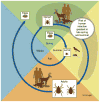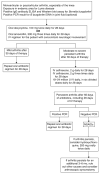Lyme disease and the orthopaedic implications of lyme arthritis
- PMID: 21292932
- PMCID: PMC3656475
- DOI: 10.5435/00124635-201102000-00004
Lyme disease and the orthopaedic implications of lyme arthritis
Abstract
Lyme disease is the most common tick-borne disease in the United States and Europe. Increased awareness of the clinical manifestations of the disease is needed to improve detection and treatment. In the acute and late stages, Lyme disease may be difficult to distinguish from other disease processes. The epidemiology and pathophysiology of Lyme disease are directly related to the Borrelia burgdorferi spirochete and its effects on the integumentary, neurologic, cardiac, and musculoskeletal systems. Lyme arthritis is a common clinical manifestation of Lyme disease and should be considered in the evaluation of patients with monoarticular or pauciarticular joint complaints in a geographic area in which Lyme disease is endemic. Management of Lyme arthritis involves eradication of the spirochete with antibiotics. Generally, the prognosis is excellent. Arthroscopic synovectomy is reserved for refractory cases that do not respond to antibiotics.
Figures







References
-
- Steere AC, Malawista SE, Snydman DR, et al. Lyme arthritis: An epidemic of oligoarticular arthritis in children and adults in three Connecticut communities. Arthritis Rheum. 1977;20(1):7–17. - PubMed
-
- Mast WE, Burrows WM., Jr Erythema chronicum migrans in the United States. JAMA. 1976;236(7):859–860. - PubMed
-
- Burgdorfer W, Barbour AG, Hayes SF, Benach JL, Grunwaldt E, Davis JP. Lyme disease: A tick-borne spirochetosis? Science. 1982;216(4552):1317–1319. - PubMed
-
- Bacon RK, Kugeler KJ, Mead PS Centers for Disease Control and Prevention (CDC) Surveillance for Lyme disease: United States, 1992–2006. MMWR Surveill Summ. 2008;57(10):1–9. - PubMed
-
- Williams CL, Strobino B, Lee A, et al. Lyme disease in childhood: Clinical and epidemiologic features of ninety cases. Pediatr Infect Dis J. 1990;9(1):10–14. - PubMed
Publication types
MeSH terms
Substances
Grants and funding
LinkOut - more resources
Full Text Sources
Other Literature Sources
Medical

